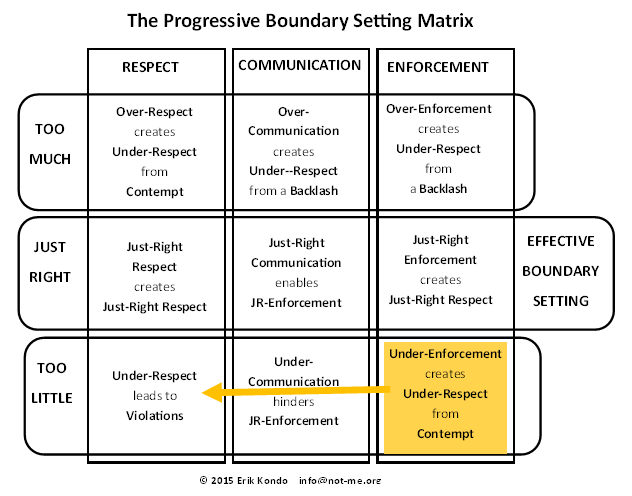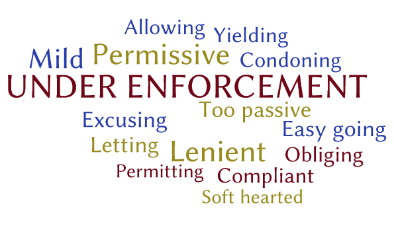Under-Enforcement is the opposite of Over-Enforcement. But it doesn’t create the opposite effect. Under-Enforcement also creates Under-Respect. It does so by the creation of Contempt.
Some words for Under-Enforcement are:
Lenient, Permissive, Too passive, Excusing, Compliant, Allowing, Easy going, Condoning, Letting, Mild, Obliging, Permitting, Soft-hearted, Yielding
Under-Enforcement creates Under-Respect which is also known as:
Contempt, Distain, Disrespect, Antipathy, Disregard, Derision, Neglect, Distaste, Defiance, Aversion, Disgust, Pity
These words all represent an emotional reaction. Under-Respect is not based on logic. It would be logical to assume that if someone is “too nice” to you, then you would respond in kind. But, people tend to take advantage of people who are too nice to them. When it comes to dealing with a violation of the rules, Under-Enforcement does not create the deterrent necessary to change unwanted behavior.
Under-Enforcement differs from Over-Enforcement in that it creates a less powerful emotion than Over-Enforcement. Over-Enforcement has the potential to immediately escalate into an ever expanding cycle of response and counter-response. The Contempt created by Under-Enforcement is likely to develop a little slower. As a result, Under-Enforcement can be followed by a progressively higher level of enforcement.
Under-Enforcement provides the opportunity to step up to Just-Right Enforcement. But Over-Enforcement is harder to step down from. Therefore, it is generally better to start low and move progressively (rapidly if necessary) higher. Than to start high and try to move lower. Once a Backlash has been created it is difficult to dissipate it. Contempt on the other hand, is easier to erase with a higher level of enforcement.
For example, you might speed at the threat of a $50 dollar fine. But as the fine increases, it is likely to create a greater and greater deterrent. The point at which the fine changes your behavior to following the speed limit is Just-Right Enforcement.
The following video is an example of how Under-Enforcement by the police, led to the rioters attacking them in mass.
This next example shows a domestic violence situation where the boyfriend is repeatedly slapped. He makes no attempt to enforce his personal boundary of acceptable behavior. Clearly, his girlfriend has Under-Respect for him.
This next video shows an old man who is repeatedly touching women as they pass by him. There is no enforcement of his unwanted behavior, so he continues to do it. Enforcement could come from the victims, or it could come from bystanders, or the police.
Just as in Over-Enforcement, what constitutes Under-Enforcement is in the eye of the Beholder. Under-Enforcement can be judged by its effectiveness. The goal of enforcement is to change behavior. It creates Respect by the elimination of disrespect. When the unwanted behavior continues, it is a sure sign that the level of enforcement is too low.
Given that both Under-Enforcement and Over-Enforcement create Under-Respect, it is easy to see why boundary setting has the potential to fail. A systemic failure occurs when the enforcer believes that his or her level of enforcement is appropriate for the situation, but the violator sees it as Under-Enforcement. In this case, the enforcer is only looking at the level of enforcement relative to herself. She is not taking into consideration how the violator views it.
Another systemic boundary setting failure occurs among people who are overly afraid of creating a Backlash via Over-Enforcement. These people will consistently Under-Enforce due to fear of Over-Enforcement. They don’t progressively increase their enforcement level to reach Just-Right Enforcement. As a result, the create Contempt. This contempt leads to further and most likely more severe violations of behavioral rules.
A common example of this situation, is a young socially conditioned woman, who is afraid to assertively standup to a man who is giving her unwanted attention. Her fear of making him angry leads her to behave in a passive submissive manner. The man, seeing that he can break her personal boundaries without consequence will now have a greater level of Under-Respect for her.
This type of woman doesn’t understand that in many situations, assertive (not aggressive) use of her voice is all that is needed to enforce her personal boundaries. She also doesn’t understand that a predatory man with a high level of bad intent will be greatly encouraged by her passive submissive behavior.
This final video shows the abduction of Carlie Brucia who was later found raped and murdered.
NOTE: Many people’s lifetime of social encounters have conditioned them to respond in a certain manner to conflict. Most likely, this response proved to be successful in most social situations. Thus, it has become the person’s default response. The problem arises when the conflict is not social, but asocial/predatory. In this situation, social responses of passive Under-Enforcement and/or verbal Over-Communication are likely to lead to a disastrous result.
Related:
How Over-Enforcement Creates Under-Respect from a Backlash – Erik Kondo
Contolling Chaos and Mayhem with the Progressive Boundary Setting Matrix – Erik Kondo

